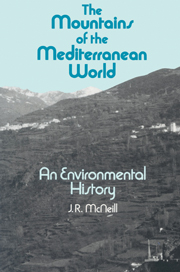Book contents
- Frontmatter
- Contents
- List of Illustrations and Tables
- Preface
- Note on Transliteration
- List of Abbreviations
- 1 The Argument: Ecology, Economy, Shells, and Skeletons
- 2 Mediterranean Mountain Environments
- 3 The Deep History of Mediterranean Landscapes
- 4 Material Life in the Mountain Environment, 1700–1900
- 5 Population, Settlement, and Landscapes
- 6 Political Economy and Mountain Landscapes
- 7 The Changing Landscape since 1800
- 8 Conclusion
- Bibliography
- Index
4 - Material Life in the Mountain Environment, 1700–1900
Published online by Cambridge University Press: 29 September 2009
- Frontmatter
- Contents
- List of Illustrations and Tables
- Preface
- Note on Transliteration
- List of Abbreviations
- 1 The Argument: Ecology, Economy, Shells, and Skeletons
- 2 Mediterranean Mountain Environments
- 3 The Deep History of Mediterranean Landscapes
- 4 Material Life in the Mountain Environment, 1700–1900
- 5 Population, Settlement, and Landscapes
- 6 Political Economy and Mountain Landscapes
- 7 The Changing Landscape since 1800
- 8 Conclusion
- Bibliography
- Index
Summary
Cultivation when it progresses spontaneously and is not consciously controlled… leaves deserts behind it.
Marx to Engels, 25 March 1868.Forest precedes civilizations and deserts follow.
Chateaubriand (1768–1848)By 1700, and in some cases well before, the Pindus, Apennines, Sierra Nevada, and Rif supported considerable peasant populations. So did other Mediterranean ranges, such as the Lebanon, the Dinaric Alps, and the Algerian Tell. The Taurus did not, and would not, until the late nineteenth century. These mountain populations lived precariously in the face of hunger and sometimes famine, sickness and sometimes epidemic, brigandage and sometimes war. In material terms, their existence, whether in the Pindus or the Rif, consisted of much the same elements: the quiet daily struggle for food, water, shelter, fuel. They fought these battles against the same enemies and in much the same terrain. So, although I will often point out differences from place to place, I will treat the material base of mountain life in the Mediterranean as a whole.
The period from 1700 to 1900, and even 1950 on occasion, I will also treat as a whole. This does not imply the view that history was somehow immobile in these centuries – merely that in material life continuities strongly outweighed changes. I would not make this claim for the centuries before 1700, when mountain settlement in the Pindus and resettlement in the Alpujarra brought radical changes.
- Type
- Chapter
- Information
- The Mountains of the Mediterranean World , pp. 104 - 146Publisher: Cambridge University PressPrint publication year: 1992

